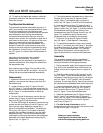
655 and 655R Actuators
Instruction Manual
Form 1292
July 2007
7
4. Slowly open the upstream shutoff valve.
Startup For Pressure-Relief Service
1. Open the needle valve in the control line.
2. Open the downstream shutoff valve.
3. Slowly open the upstream shutoff valve.
4. Close the valve in the bypass line.
Adjustment For Pressure-Reducing or
Pressure-Relief Service
The actuator is factory-set as specified on the order,
and the pressure range is stamped on the
nameplate. If a pressure setting other than the one
specified is desired, change the pressure setting by
following the procedures listed below. Be sure to
change the nameplate to indicate the new pressure
setting. The new pressure setting must not exceed
the limits given in tables 1 and 2 or in any applicable
codes.
CAUTION
To protect equipment in the process
system from a sudden release of
pressure, always use a pressure gauge
to monitor pressure when making
adjustments.
To adjust the downstream pressure setting for
pressure-reducing service, or the upstream pressure
setting for pressure-relief service, proceed as
follows. To decrease the pressure setting, turn the
adjusting screw (key 10, figure 4) counterclockwise;
to increase the pressure setting, turn the adjusting
screw clockwise. If the spring does not provide the
required pressure setting, replace it through the
following steps:
1. Disassemble the actuator by following steps 1, 3
and 4 of the Disassembly portion of the Maintenance
section.
2. Remove the diaphragm (key 2). Then, unscrew
the cap screw (key 3), and lift the diaphragm plate
(key 4) out of the actuator body.
3. Replace the spring and reassemble the actuator
by following steps 5 and 6 of the Assembly portion of
the Maintenance section.
Shutdown
For both pressure-reducing and pressure-relief
applications, refer to figure 2, and follow the
procedures described below.
1. Close the upstream shutoff valve slightly.
2. Slowly open the bypass valve while monitoring
downstream pressure.
3. Slowly close the downstream shutoff valve.
4. Close the upstream shutoff valve.
5. Close the needle valve in the control line.
Maintenance
Actuator parts are subject to normal wear and must
be inspected and replaced when necessary. The
frequency of inspection and replacement depends
on the severity of service conditions.
WARNING
Avoid personal injury or property
damage from sudden release of
process pressure or bursting of parts.
Before performing any maintenance
operations:
D Always wear protective gloves,
clothing, and eyewear when
performing any maintenance
operations to avoid personal injury.
D Disconnect any operating lines
providing air pressure, electric power,
or a control signal to the actuator. Be
sure the actuator cannot suddenly
open or close the valve.
D Use bypass valves or completely
shut off the process to isolate the
valve from process pressure. Relieve
process pressure from both sides of
the valve. Drain the process media
from both sides of the valve.
D Vent the power actuator loading
pressure and relieve any actuator
spring precompression.
D Use lock-out procedures to be
sure that the above measures stay in
effect while you work on the
equipment.
D The valve packing box may
contain process fluids that are


















